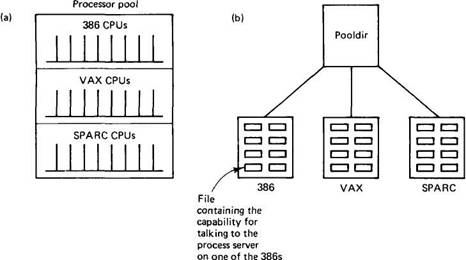Книга: Distributed operating systems
7.6.4.The Run Server
7.6.4.The Run Server
When the user types a command (e.g., sort) at the terminal, two decisions must be made:
1. On what architecture type should the process be run?
2. Which processor should be chosen?
The first question relates to whether the process should run on a 386, SPARC, 680x0, and so on. The second relates to the choice of the specific CPU and depends on the load and memory availability of the candidate processors. The run server helps make these decisions.
Each run server manages one or more processor pools. A processor pool is represented by a directory called a pooldir, which contains subdirectories for each of the CPU architectures supported. The subdirectories contain capabilities for accessing the process servers on each of the machines in the pool. An example arrangement is shown in Fig. 7-26. Other arrangements are also possible, including mixed and overlapping pools, and dividing pools into subpools.

Fig. 7-26. (a) A processor pool. (b) The corresponding pooldir.
When the shell wants to run a program, it looks in /bin to find, say, sort. If sort is available for multiple architectures, sort will not be a single file, but a directory containing executable programs for each available architecture. The shell then does an RPC with the run server sending it all the available process descriptors and asking it to pick both an architecture and a specific CPU.
The run server then looks in its pooldir to see what it has to offer. The selection is made approximately as follows. First, the intersection of the process descriptors and pool processors is computed. If there are process descriptors (i.e., binary programs) for the 386, SPARC, and 680x0, and this run server manages 386, SPARC, and VAX pool processors, only the 386 is a possibility, so the other machines are eliminated as candidates.
Second, the run server checks to see which of the candidate machines have enough memory to run the program. Those that do not are also eliminated. The run server keeps track of the memory and CPU usage of each of its pool processors by making getload calls to each one regularly to request these values, so the numbers in the run server's tables are continuously refreshed.
Third, and last, for each of the remaining machines, an estimate is obtained of the computing power that can be devoted to the new program. Each CPU makes its own estimate. The heuristic used takes as input the known total computing power of the CPU and the number of currently active threads running on it. For example, if a 20-MIPS machine currently has four active threads, the addition of a fifth one means that each one, including the new one, will get 4 MIPS on the average. If another processor has 10 MIPS and one thread, on this machine the new program can expect 5 MIPS. The run server chooses the processor that can deliver the most MIPS and returns the capability for talking to its process server to the caller. The caller then uses this capability to create the process, as described in Sec. 7.3.
- CHAPTER 17 Apache Web Server Management
- Runtime Configuration Directives
- Starting the Very Secure FTP Server (vsftpd) Package
- Running the named Nameserver Daemon
- Тестирование Web-сервиса XML с помощью WebDev.WebServer.exe
- InterBase Super Server для Windows
- Каталог BIN в SuperServer
- Минимальный состав сервера InterBase SuperServer
- InterBase Classic Server под Linux
- Каталог BIN в InterBase Classic Server для Linux
- SuperServer
- Classic vs SuperServer




